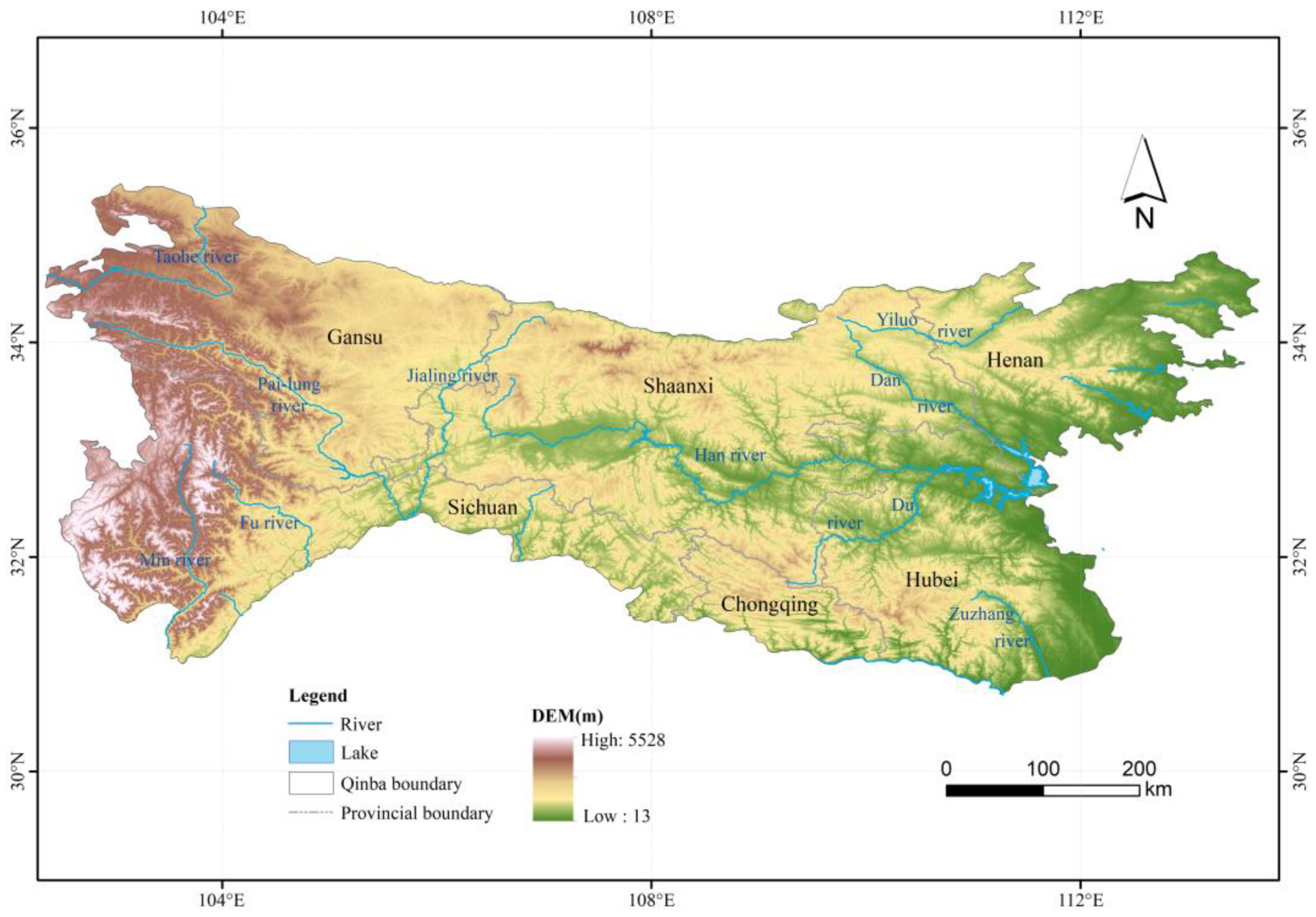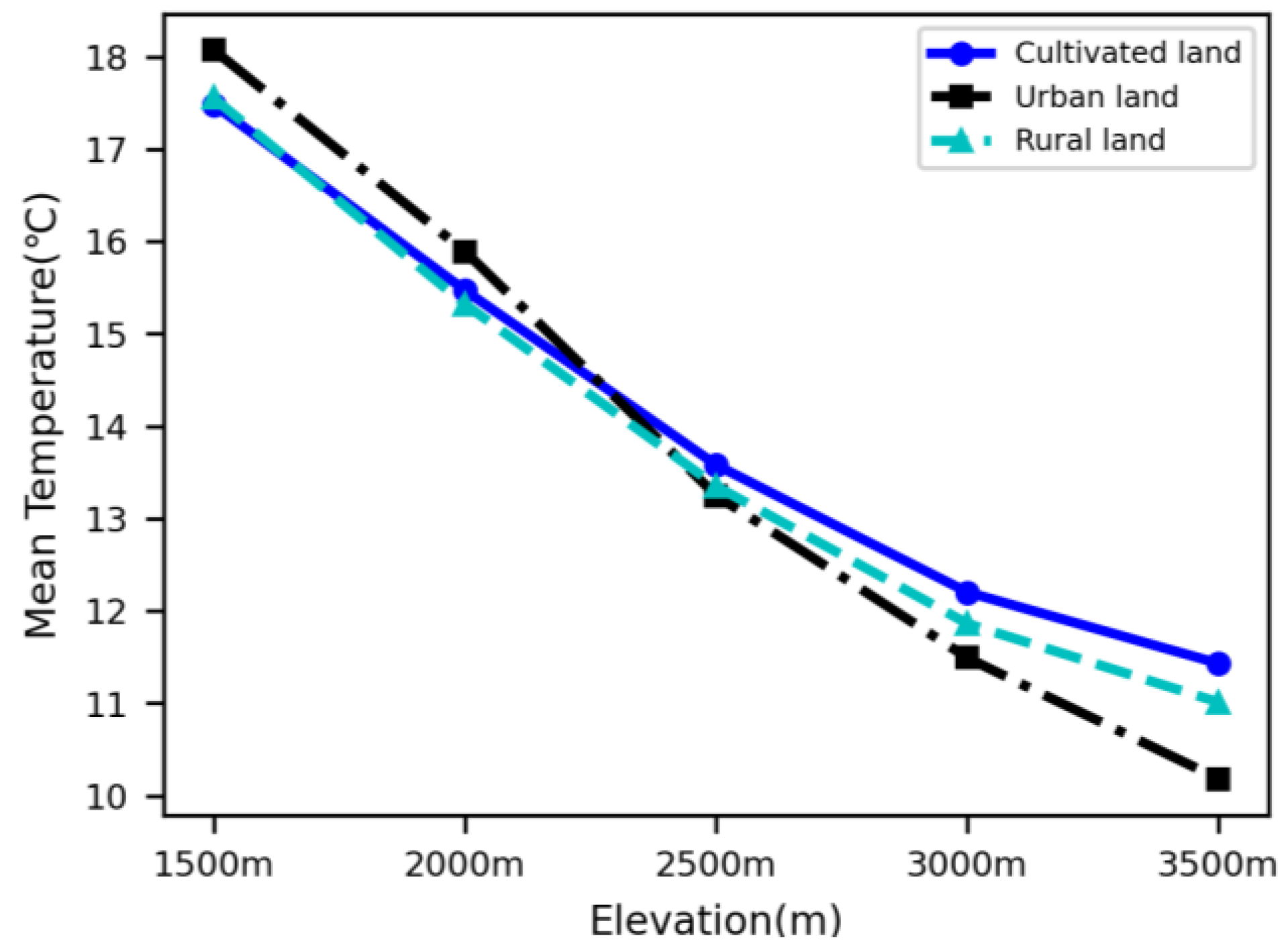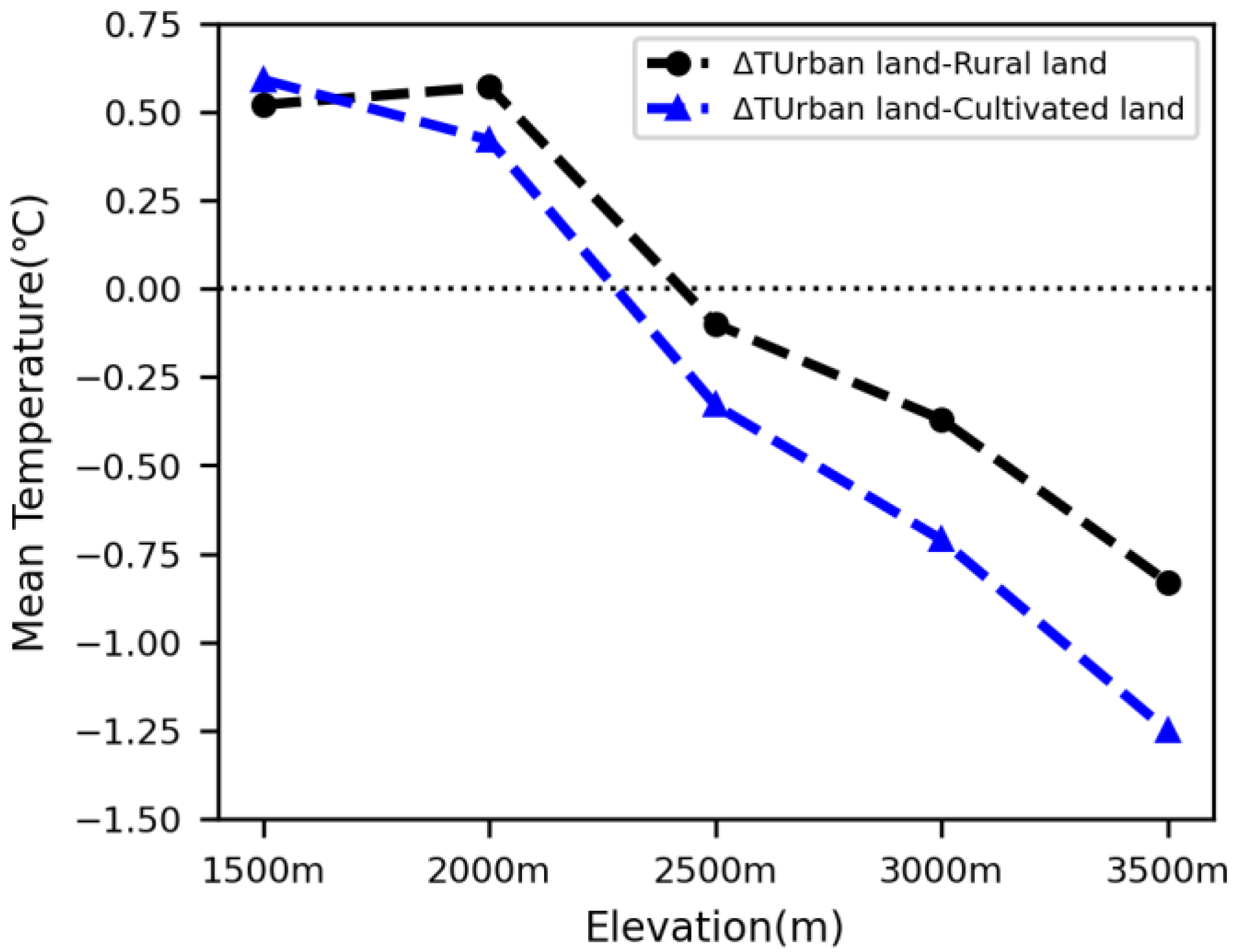Estimation of Urban–Rural Land Surface Temperature Difference at Different Elevations in the Qinling–Daba Mountains Using MODIS and the Random Forest Model
Abstract
:1. Introduction
2. Materials and Methods
2.1. Data and Processing
2.1.1. MODIS Data
2.1.2. DEM Data
2.1.3. Land Use Data
2.2. Random Forest Method
3. Results
3.1. Estimation of LST at the Same Elevations in the Qinling–Daba Mountains
3.1.1. Accuracy Assessment of Estimating LST at the Same Elevations Based on the Random Forest Model
3.1.2. Variation of Estimated LST at the Same Elevations in the Qinling–Daba Mountains
3.2. Comparison of LST of Urban, Rural and Cultivated Land at Different Elevations
4. Discussion
5. Conclusions
- (1)
- The random forest method and MODIS data can be used to estimate LST at standard elevations. It was shown that the LST estimated using MODIS and the random forest method has obvious linear correlation with the original LST, with R2 values of >0.9 at elevations of 1500 m, 2000 m, 2500 m, 3000 m and 3500 m.
- (2)
- The difference in urban–rural LST has a trend of decrease with increasing elevation, meaning that the SUHI tends to weaken at higher elevations. The average LST of urban areas is 0.52–0.59 °C higher than that of rural and cultivated lands at 1500 m, but the former is 0.42–0.57 °C higher than the latter at the elevation of 2000 m.
- (3)
- The average LST of urban areas is less than that of rural areas at elevations of ≥2500 m, meaning that the SUHI disappears in the middle and alpine mountains in the Qinling–Daba mountains. The average LST of urban areas is 0.1 °C, 0.37 °C, and 0.83 °C (0.33 °C, 0.71 °C and 1.25 °C) lower than that of rural and cultivated lands at elevations of 2500 m, 3000 m, and 3500 m, respectively.
Author Contributions
Funding
Institutional Review Board Statement
Informed Consent Statement
Data Availability Statement
Acknowledgments
Conflicts of Interest
References
- Landsberg, H.E. The Urban Climate; Academic Press: Cambridge, MA, USA, 1981; pp. 84–123. [Google Scholar]
- Tang, X.; Cui, Y.; Li, N.; Fu, Y.; Dong, J. Human Activities Enhance Radiation Forcing through Surface Albedo Associated with Vegetation in Beijing. Remote Sens. 2020, 12, 837. [Google Scholar] [CrossRef]
- Zhu, W.; Zhang, J.; Cui, Y.; Zhu, L. Ecosystem carbon storage under different scenarios of land use change in Qihe catchment, China. Geogr. Res. 2020, 30, 16. [Google Scholar] [CrossRef]
- Voogt, J.A.; Oke, T.R. Thermal remote sensing of urban climates. Remote Sens. Environ. 2003, 86, 370–384. [Google Scholar] [CrossRef]
- Estoque, R.C.; Murayama, Y.; Myint, S.W. Effects of landscape composition and pattern on land surface temperature: An urban heat island study in the megacities of Southeast Asia. Sci. Total Environ. 2017, 577, 349–359. [Google Scholar] [CrossRef]
- Howard, L. The Climate of London: Deduced from Meteorological Observations, Made at Different Places in the Neighbourhood of the Metropolis; Harvard University Press: Cambridge, MA, USA, 1818; Volume 1. [Google Scholar]
- Wang, K.; Jiang, S.; Wang, J.; Zhou, C.; Wang, X.; Lee, X. Comparing the diurnal and seasonal variabilities of atmospheric and surface urban heat islands based on the Beijing urban meteorological network. J. Geophys. Res. Atmos. 2017, 122, 2131–2154. [Google Scholar] [CrossRef]
- Yang, Y.; Su, W.; Jiang, N.; Zhen, F. Spatia-l temporal characteristics of urban heat island effect change of Nanjing city and its relation with land use change. Geogr. Res. 2007, 26, 877–887. (In Chinese) [Google Scholar]
- Gallo, K.; McNab, A.; Karl, T.R.; Brown, J.F.; Hood, J.; Tarpley, J. The use of a vegetation index for assessment of the urban heat island effect. Int. J. Remote Sens. 1993, 14, 2223–2230. [Google Scholar] [CrossRef]
- Rosenzweig, C.; Solecki, W.D.; Parshall, L.; Chopping, M.; Pope, G.; Goldberg, R. Characterizing the urban heat island in current and future climates in New Jersey. Environ. Hazards 2005, 6, 51–62. [Google Scholar] [CrossRef]
- Suomi, J. Characteristics of urban heat island (UHI) in a high latitude coastal city-a case study of Turku, SW Finland. Ann. Univ. Turku. 2014. [Google Scholar]
- Imhoff, M.L.; Zhang, P.; Wolfe, R.E.; Bounoua, L. Remote sensing of the urban heat island effect across biomes in the continental USA. Remote Sens. Environ. 2010, 114, 504–513. [Google Scholar] [CrossRef]
- Lan, X.; Li, W.; Tang, J.; Shakoor, A.; Zhao, F.; Fan, J. Spatiotemporal variation of climate of different flanks and elevations of the Qinling–Daba mountains in China during 1969–2018. Sci. Rep. 2022, 12, 6952. [Google Scholar] [CrossRef] [PubMed]
- Wang, W.; Wang, J.; Du, J. Land surface evapotranspiration estimation of Yiluo River Basin based on fusion of ETM+ and MODIS data. Geogr. Res. 2013, 32, 817–827. (In Chinese) [Google Scholar]
- Kang, Z.; Zhang, Z.; Liu, L.; Wang, T.; Tian, H.; Chen, H.; Zhang, X. Spatio-temporal variation characteristics of land surface temperature in Xinjiang based on MODIS. Geogr. Res. 2022, 41, 997–1017. (In Chinese) [Google Scholar]
- Mathew, A.; Khandelwal, S.; Kaul, N. Investigating spatial and seasonal variations of urban heat island effect over Jaipur city and its relationship with vegetation, urbanization and elevation parameters. Sustain. Cities Soc. 2017, 35, 157–177. [Google Scholar] [CrossRef]
- Flenley, J. Ultraviolet insolation and the tropical rainforest: Altitudinal variations, Quaternary and recent change, extinctions, and biodiversity. In Tropical Rainforest Responses to Climatic Change; Springer: Berlin/Heidelberg, Germany, 2007; pp. 219–235. [Google Scholar]
- Zhang, B.; Yao, Y.; Zhao, F. Studies on Mass Elevation Effect; China Environmental Science Press: Beijing, China, 2015; pp. 3–8. (In Chinese) [Google Scholar]
- Zhao, F.; Zhang, B.; Pang, Y.; Yao, Y. A study of the contribution of mass elevation effect to the altitudinal distribution of timberline in the Northern Hemisphere. Geogr. Sci. 2014, 24, 226–236. [Google Scholar] [CrossRef]
- Holtmeier, F.-K. Mountain Timberlines; Springer: Berlin/Heidelberg, Germany, 2009; pp. 293–333. [Google Scholar]
- Oke, T.R. City size and the urban heat island. Atmos. Environ. 1973, 7, 769–779. [Google Scholar] [CrossRef]
- Liu, W.; Ji, C.; Zhong, J.; Jiang, X.; Zheng, Z. Temporal characteristics of the Beijing urban heat island. Theor. Appl. Climatol. 2007, 87, 213–221. [Google Scholar] [CrossRef]
- Ganbat, G.; Han, J.-Y.; Ryu, Y.-H.; Baik, J. Characteristics of the urban heat island in a high-altitude metropolitan city, Ulaanbaatar, Mongolia. Asia-Pac. J. Atmos. Sci. 2013, 49, 535–541. [Google Scholar] [CrossRef]
- Yao, Y.; Xu, M.; Zhang, B. Implication of the heating effect of the Tibetan Plateau for mountain altitudinal belts. Acta Geogr. Sin. 2015, 70, 407–419. (In Chinese) [Google Scholar]
- Liu, J.; Pan, Z.; Qin, F.; Gu, J.; Zhu, M.; Zhao, F. Estimation of air temperature based on MODIS and analysis of mass elevation effect in the Qinling-Daba Mountains. Geogr. Res. 2020, 39, 735–748. (In Chinese) [Google Scholar]
- He, J.; Zhao, W.; Li, A.; Wen, F.; Yu, D. The impact of the terrain effect on land surface temperature variation based on Landsat-8 observations in mountainous areas. Int. J. Remote Sens. 2019, 40, 1808–1827. [Google Scholar] [CrossRef]
- Minder, J.R.; Mote, P.W.; Lundquist, J.D. Surface temperature lapse rates over complex terrain: Lessons from the Cascade Mountains. J. Geophys. Res.-Atmos. 2010, 115. [Google Scholar] [CrossRef]
- Stroppiana, D.; Antoninetti, M.; Brivio, P.A. Seasonality of MODIS LST over Southern Italy and correlation with land cover, topography and solar radiation. Eur. J. Remote Sens. 2014, 47, 133–152. [Google Scholar] [CrossRef]
- Suo, N.; Yao, Y.; Zhang, B. Comparative study on the mountain elevation effect of the Tibetan Plateau and the Alps. Geogr. Res. 2020, 39, 2568–2580. (In Chinese) [Google Scholar]
- Tang, Z.; Fang, J. Temperature variation along the northern and southern slopes of Mt. Taibai, China. Agr. For. Meteorol. 2006, 139, 200–207. [Google Scholar] [CrossRef]
- Zhao, W.; Duan, S.-B.; Li, A.; Yin, G. A practical method for reducing terrain effect on land surface temperature using random forest regression. Remote Sens. Environ. 2019, 221, 635–649. [Google Scholar] [CrossRef]
- Ouyang, X.; Dou, Y.; Yang, J.; Chen, X.; Wen, J. High Spatiotemporal Rugged Land Surface Temperature Downscaling over Saihanba Forest Park, China. Remote Sens. 2022, 14, 2617. [Google Scholar] [CrossRef]
- Zhao, F.; Liu, J.; Zhu, W.; Zhang, B.; Zhu, L. Spatial variation of altitudinal belts as dividing index between warm temperate and subtropical zones in the Qinling-Daba Mountains. J. Geogr. Sci. 2020, 30, 642–656. [Google Scholar] [CrossRef]
- Zhao, F.; Lan, X.; Li, W.; Zhu, W.; Li, T. Influence of land use change on the surface albedo and climate change in the qinling-daba mountains. Sustainability 2021, 13, 10153. [Google Scholar] [CrossRef]
- Wang, L.; Chen, S.; Zhu, W.; Ren, H.; Zhu, L. Spatiotemporal variations of extreme precipitation and its potential driving factors in China’s North-South Transition Zone during 1960–2017. Atmos. Res. 2021, 252, 105429. [Google Scholar] [CrossRef]
- Liang, S. Narrowband to broadband conversions of land surface albedo I: Algorithms. Remote Sens. Environ. 2001, 76, 213–238. [Google Scholar] [CrossRef]
- Song, S.; He, R. Variable Measure index system based on random forest. Comput. Modeling Eng. Sci. 2021, 43, 8. (In Chinese) [Google Scholar]
- Xing, L.; Li, J.; Jiao, W. Estimation of daily maximum and minimum temperature of Lanzhou City based on MODIS and random forest. Arid Zone Res. 2020, 37, 7. (In Chinese) [Google Scholar]
- Hua, J.; Zhu, S.; Zhang, G. Downscaling land surface temperature based on random forest algorithm. Remote Sens. Land Resour. 2018, 30, 9. (In Chinese) [Google Scholar]
- Xie, Y.; Fan, X.; Han, T.; Duan, H. Surface temperature inversion and the urban heat island effect of Lanzhou based on TM. J. Arid. Land Resour. Environ. 2011, 25, 172–175. (In Chinese) [Google Scholar]
- Ziqiang, L.; Fang, Z.; Mengtao, H.; Xiaosong, W.; Hongchun, P. Change Analysis of City Correlation Index Based on Landsat 8 Satellite Data. Geospat. Inf. 2017, 15, 4. (In Chinese) [Google Scholar]
- Liyuan, L.; Baoping, L. Spatial-temporal Analysis of Urban Heat Island Effect and the Typical Surface Parameters Variation: Case Study of Guilin. Geomat. Spat. Inf. Technol. 2016, 39, 5. (In Chinese) [Google Scholar]
- Yuan, L.; Cu, H.; Xiaoxiong, Y.; Yanfei, W. Quantitative Analysis of Urban Thermal Environmental Effect Based on ASTER Data. Geomat. Inf. Sci. Wuhan Univ. 2008, 33, 297–301. (In Chinese) [Google Scholar]
- Baoping, L.; Yi, L.; Kezhou, C. A Research on Land Features and Correlation between NDVI and Land Surface Temperature in Guilin City. Remote Sens. Technol. Appl. 2012, 27, 429–435. (In Chinese) [Google Scholar]
- Hua, L.; Yongnian, Z.; Qinhuo, L. A Remote Sensing Image-Based Study of the Relationship between Urban Heat Island and Land Use/Cover Changes in Changsha city. Remote Sens. Land Resour. 2008, 7, 47–52. (In Chinese) [Google Scholar]
- Schultz, N.M.; Lawrence, P.J.; Lee, X. Global satellite data highlights the diurnal asymmetry of the surface temperature response to deforestation. Geophys. Res. Biogeosci. 2017, 122, 903–917. [Google Scholar] [CrossRef]
- Shufen, S. Physical, Biochemical Mechanisms and Parametric Models of Land Surface Processes; Meteorological Press: Beijing, China, 2005; Volume 1. (In Chinese) [Google Scholar]
- Shreve, F. Conditions Indirectly Affecting Vertical Distribution on Desert Mountains. Ecology 1922, 3, 269. [Google Scholar] [CrossRef]
- Bonan, G.B. Forests and Climate Change: Forcings, Feedbacks, and the Climate Benefits of Forests. Science 2008, 320, 1444–1449. [Google Scholar] [CrossRef] [PubMed]
- Yao, Y.; Zhang, B. The mass elevation effect of the Tibetan Plateau and its implications for Alpine treelines. Int. J. Climatol. 2015, 35, 1833–1846. [Google Scholar] [CrossRef]
- Yao, Y.; Zhang, B. MODIS-based estimation of air temperature and heating-up effect of the Tibetan Plateau. Acta Geogr. Sin. 2013, 68, 95–107. (In Chinese) [Google Scholar]
- Zhang, B.; Yao, Y. Implications of mass elevation effect for the altitudinal patterns of global ecology. J. Geogr. Sci. 2016, 26, 871–877. [Google Scholar] [CrossRef]
- Kim, Y.-H.; Baik, J. Spatial and temporal structure of the urban heat island in Seoul. J. Appl. Meteorol. Clim. 2005, 44, 591–605. [Google Scholar] [CrossRef]
- Cui, Y.; Xu, X.; Dong, J.; Qin, Y. Influence of Urbanization Factors on Surface Urban Heat Island Intensity: A Comparison of Countries at Different Developmental Phases. Sustainability 2016, 8, 706. [Google Scholar] [CrossRef]
- Powlson, D.S.; Whitmore, A.P.; Goulding, K.W.T. Soil carbon sequestration to mitigate climate change: A critical re-examination to identify the true and the false. Eur. J. Soil Sci. 2011, 62, 42–55. [Google Scholar] [CrossRef]






| Variable | Datasets | Temporal Resolution | Spatial Resolution |
|---|---|---|---|
| Land surface temperature (LST) | MOD11A1 | 8 Day | 1 km |
| Normalized difference water index (NDWI) | MOD09A1 | 8 Day | 500 m |
| Normalized difference vegetation index (NDVI) | MOD13A2 | 16 Day | 1 km |
| Surface albedo (ALB) | MOD09A1 | 8 Day | 500 m |
| Land cover type (LCT) | MCD12Q1 | Year | 500 m |
| Evapotranspiration (ET) | MOD16A2 | 8 Day | 500 m |
| Statistical Indicators | 1500 m | 2000 m | 2500 m | 3000 m | 3500 m |
|---|---|---|---|---|---|
| R2 | 0.90 | 0.97 | 0.98 | 0.98 | 0.97 |
| RMSE | 0.79 | 0.92 | 0.93 | 0.97 | 1.02 |
| 1500 m | 2000 m | 2500 m | 3000 m | 3500 m | |
|---|---|---|---|---|---|
| Urban land | 18.07 | 15.89 | 13.25 | 11.49 | 10.18 |
| Rural land | 17.55 | 15.32 | 13.35 | 11.86 | 11.01 |
| Cultivated land | 17.48 | 15.47 | 13.58 | 12.2 | 11.43 |
| 1500 m | 2000 m | 2500 m | 3000 m | 3500 m | |
|---|---|---|---|---|---|
| ΔTUrban land–Rural land | 0.52 | 0.57 | −0.10 | −0.37 | −0.83 |
| ΔTUrban land–Cultivated land | 0.59 | 0.42 | −0.33 | −0.71 | −1.25 |
Publisher’s Note: MDPI stays neutral with regard to jurisdictional claims in published maps and institutional affiliations. |
© 2022 by the authors. Licensee MDPI, Basel, Switzerland. This article is an open access article distributed under the terms and conditions of the Creative Commons Attribution (CC BY) license (https://creativecommons.org/licenses/by/4.0/).
Share and Cite
Tang, J.; Lan, X.; Lian, Y.; Zhao, F.; Li, T. Estimation of Urban–Rural Land Surface Temperature Difference at Different Elevations in the Qinling–Daba Mountains Using MODIS and the Random Forest Model. Int. J. Environ. Res. Public Health 2022, 19, 11442. https://doi.org/10.3390/ijerph191811442
Tang J, Lan X, Lian Y, Zhao F, Li T. Estimation of Urban–Rural Land Surface Temperature Difference at Different Elevations in the Qinling–Daba Mountains Using MODIS and the Random Forest Model. International Journal of Environmental Research and Public Health. 2022; 19(18):11442. https://doi.org/10.3390/ijerph191811442
Chicago/Turabian StyleTang, Jiale, Xincan Lan, Yuanyuan Lian, Fang Zhao, and Tianqi Li. 2022. "Estimation of Urban–Rural Land Surface Temperature Difference at Different Elevations in the Qinling–Daba Mountains Using MODIS and the Random Forest Model" International Journal of Environmental Research and Public Health 19, no. 18: 11442. https://doi.org/10.3390/ijerph191811442
APA StyleTang, J., Lan, X., Lian, Y., Zhao, F., & Li, T. (2022). Estimation of Urban–Rural Land Surface Temperature Difference at Different Elevations in the Qinling–Daba Mountains Using MODIS and the Random Forest Model. International Journal of Environmental Research and Public Health, 19(18), 11442. https://doi.org/10.3390/ijerph191811442







